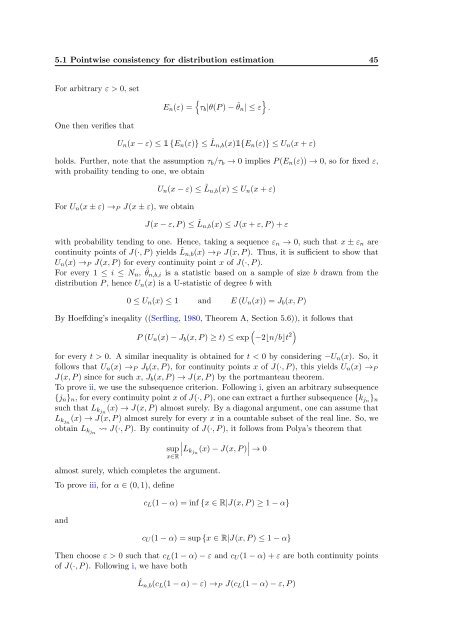Subsampling estimates of the Lasso distribution.
Subsampling estimates of the Lasso distribution.
Subsampling estimates of the Lasso distribution.
You also want an ePaper? Increase the reach of your titles
YUMPU automatically turns print PDFs into web optimized ePapers that Google loves.
5.1 Pointwise consistency for <strong>distribution</strong> estimation 45<br />
For arbitrary ε > 0, set<br />
E n (ε) =<br />
{<br />
τ b |θ(P ) − ˆθ<br />
}<br />
n | ≤ ε .<br />
One <strong>the</strong>n verifies that<br />
U n (x − ε) ≤ 1 {E n (ε)} ≤ ˆL n,b (x)1{E n (ε)} ≤ U n (x + ε)<br />
holds. Fur<strong>the</strong>r, note that <strong>the</strong> assumption τ b /τ b → 0 implies P (E n (ε)) → 0, so for fixed ε,<br />
with probaility tending to one, we obtain<br />
For U n (x ± ε) → P J(x ± ε), we obtain<br />
U n (x − ε) ≤ ˆL n,b (x) ≤ U n (x + ε)<br />
J(x − ε, P ) ≤ ˆL n,b (x) ≤ J(x + ε, P ) + ε<br />
with probability tending to one. Hence, taking a sequence ε n → 0, such that x ± ε n are<br />
continuity points <strong>of</strong> J(·, P ) yields ˆL n,b (x) → P J(x, P ). Thus, it is sufficient to show that<br />
U n (x) → P J(x, P ) for every continuity point x <strong>of</strong> J(·, P ).<br />
For every 1 ≤ i ≤ N n , ˆθ n,b,i is a statistic based on a sample <strong>of</strong> size b drawn from <strong>the</strong><br />
<strong>distribution</strong> P , hence U n (x) is a U-statistic <strong>of</strong> degree b with<br />
0 ≤ U n (x) ≤ 1 and E (U n (x)) = J b (x, P )<br />
By Hoeffding’s ineqality ((Serfling, 1980, Theorem A, Section 5.6)), it follows that<br />
P (U n (x) − J b (x, P ) ≥ t) ≤ exp<br />
(−2⌊n/b⌋t 2)<br />
for every t > 0. A similar inequality is obtained for t < 0 by considering −U n (x). So, it<br />
follows that U n (x) → P J b (x, P ), for continuity points x <strong>of</strong> J(·, P ), this yields U n (x) → P<br />
J(x, P ) since for such x, J b (x, P ) → J(x, P ) by <strong>the</strong> portmanteau <strong>the</strong>orem.<br />
To prove ii, we use <strong>the</strong> subsequence criterion. Following i, given an arbitrary subsequence<br />
{j n } n , for every continuity point x <strong>of</strong> J(·, P ), one can extract a fur<strong>the</strong>r subsequence {k jn } n<br />
such that L kjn (x) → J(x, P ) almost surely. By a diagonal argument, one can assume that<br />
L kjn (x) → J(x, P ) almost surely for every x in a countable subset <strong>of</strong> <strong>the</strong> real line. So, we<br />
obtain L kjn J(·, P ). By continuity <strong>of</strong> J(·, P ), it follows from Polya’s <strong>the</strong>orem that<br />
∣<br />
sup ∣L kjn (x) − J(x, P ) ∣ → 0<br />
x∈R<br />
almost surely, which completes <strong>the</strong> argument.<br />
To prove iii, for α ∈ (0, 1), define<br />
and<br />
c L (1 − α) = inf {x ∈ R|J(x, P ) ≥ 1 − α}<br />
c U (1 − α) = sup {x ∈ R|J(x, P ) ≤ 1 − α}<br />
Then choose ε > 0 such that c L (1 − α) − ε and c U (1 − α) + ε are both continuity points<br />
<strong>of</strong> J(·, P ). Following i, we have both<br />
ˆL n,b (c L (1 − α) − ε) → P J(c L (1 − α) − ε, P )
















